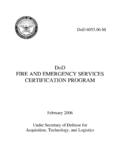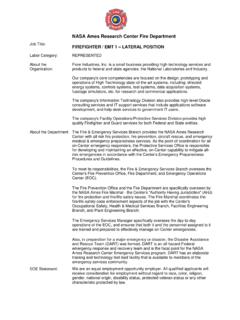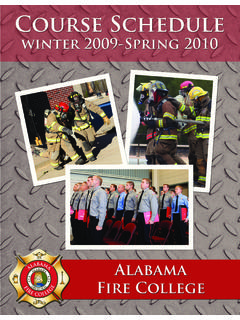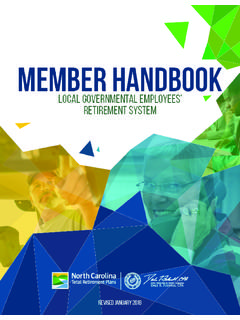Transcription of SPECIAL RETIREMENT PROVISIONS FOR LAW …
1 FAS REFERENCE GUIDE. Prepared by: Benefits and Entitlements Branch, May 2006. For Additional Information: (703) 696-6301 or DSN 426-6301. FAX: (703) 696-4705 or DSN 426-4705. SPECIAL RETIREMENT PROVISIONS FOR. LAW enforcement OFFICERS, FIREFIGHTERS AND. AIR TRAFFIC CONTROLLERS. A Guide for Human Resources Specialists Defense Civilian Personnel Management Service Field Advisory Services Division 1400 Key Boulevard, Suite B-200. Arlington, VA 22209-5144. FAS 1 of 58 May 2006. Introduction The purpose of this module is to provide human resources specialists a simple, clear document dealing with the SPECIAL RETIREMENT PROVISIONS for law enforcement officers (LEOs), firefighters (FFs) and air traffic controllers (ATCs).
2 This module should be for quick reference to the major PROVISIONS in law and regulation. It is not intended to be a complete, all-encompassing reference document. For this reason, we have included the statutory and regulatory references that can be used by the human resources specialist to answer questions or counsel employees in the course of their day-to-day responsibilities. The bulk of this module is devoted to LEOs and FFs because of the complexity of the program and the number of positions involved. A LEO or FF is an employee who occupies a position designated by the Agency Head (or designee) as a LEO or FF. position. Employees in these positions pay an extra percent salary deduction to the Civil Service RETIREMENT System (CSRS) and the Federal Employees RETIREMENT System (FERS) because of the SPECIAL RETIREMENT coverage.
3 The SPECIAL RETIREMENT PROVISIONS for LEOs and FFs allow these individuals to receive SPECIAL RETIREMENT benefits after meeting the age and service requirements. Generally, employees covered under these SPECIAL RETIREMENT PROVISIONS may retire at an earlier age with fewer years of service. However, these positions have a mandatory separation based on age as well. Issues involving law enforcement and FF coverage and eligibility are often complex. This module provides information to assist in resolving these issues. Only two Federal agencies have ATC positions, the Department of Defense (DoD) and the Department of Transportation. There are less than 1,200 ATC employees in DoD.
4 In Defense, the Component Heads have the authority to determine whether an ATC position meets the requirements for SPECIAL RETIREMENT coverage. ATCs under CSRS and FERS. can retire early and are subject to mandatory separation PROVISIONS , but there are differences in each RETIREMENT system. Under CSRS, ATCs are not required to pay extra RETIREMENT deductions and their RETIREMENT annuity is computed using the CSRS general formula, with a guaranteed minimum provision. Under FERS, ATCs pay an extra . percent into the RETIREMENT fund and if the employee has at least 20 years of ATC service, the annuity is computed using the SPECIAL RETIREMENT Formula. An employee with at least five years of frontline ATC service (actively engaged in the separation and control of air traffic) may receive an enhanced annuity (see page 49 for more information).
5 If you have any questions, we invite you to contact our office for information from one of our Benefits and Entitlements (B&E) advisors: by email by telephone (703) 696-6301, DSN 426-6301; or by fax (703) 696-4705, DSN 426-4705. FAS 2 of 58 May 2006. Table of Contents Section I Law enforcement Officers and 4. Background .. 4. Legislative History .. 5. SPECIAL RETIREMENT PROVISIONS for Law enforcement Officers (LEOs) .. 9. SPECIAL RETIREMENT PROVISIONS for Firefighters (FFs) .. 16. Service Credit Tips .. 22. Steps for Determining CSRS & CSRS-Offset SPECIAL RETIREMENT 23. Steps for Determining FERS SPECIAL RETIREMENT Coverage .. 27. Frequently Asked 31. Firefighter Pay for RETIREMENT and Life Insurance.
6 37. Firefighter Sick Leave Conversion .. 39. Worksheet 1: Old Formula for Computing FFs Annual 40. Worksheet 2: New Formula for Computing FFs Annual Salary, Unusual 42. Worksheet 3: New Formula for Computing FFs Annual Salary, Embedded Tour 44. Section II Air Traffic Controllers .. 46. SPECIAL RETIREMENT PROVISIONS for Air Traffic Controllers (ATCs) .. 46. Section III Public Safety Officers' Benefits (PSOB) 51. Section IV Sample Letters .. 53. Sample Letter CSRS LEO/FF Certification .. 53. Sample Letter FERS LEO/FF Certification .. 54. Sample Letter LEO/FF Disability RETIREMENT 55. Sample Letter LEO/FF Mandatory Separation .. 56. Sample Letter ATC Certification.
7 57. Sample Letter ATC Mandatory Separation .. 58. FAS 3 of 58 May 2006. Section I Law enforcement Officers and Firefighters Background The legislative intent behind the SPECIAL RETIREMENT PROVISIONS for LEOs and FFs was to provide for their early RETIREMENT based on a determination that these positions should be composed, insofar as possible, of young men and women physically capable of meeting the vigorous demands of occupations that are far more physically taxing than most in the Federal service. The SPECIAL RETIREMENT PROVISIONS allow LEOs and FFs to retire early with enhanced annuities. Under CSRS and FERS, LEOs and FFs can retire at age 50, if they have completed 20 years of service as a LEO/FF.
8 FERS also provides that LEOs/FFs may retire at any age, if they have at least 25 years of LEO/FF service. Under CSRS, the RETIREMENT annuity formula for LEOs/FFs is percent of their high-3 average salary for the first 20 years of LEO/FF covered service, and 2 percent of their high-3 average salary for any years of service over 20 years and other than LEO/FF service. Under FERS, the RETIREMENT annuity formula is percent of their high-3 average salary for the first 20. years of LEO/FF covered service, and 1 percent of their high-3 average salary for any years of service over 20 years. Under both CSRS and FERS, the RETIREMENT system deductions for LEOs/FFs are percent more than for regular employees.
9 To meet the goal of maintaining a young and vigorous LEO/FF work force, a mandatory separation provision was added to the law. This provides that LEOs and FFs will be separated at age 57, if they have 20 years of LEO and/or FF covered service. Employees, who do not have 20 years of LEO/FF service at age 57, are separated at the end of the month in which they attain 20 years of LEO/FF service. However, if an employee with 20 years of LEO/FF covered service is no longer in a LEO/FF covered position, the mandatory separation PROVISIONS do not apply. The law also allows Federal agencies to establish maximum entry ages for LEO/FF positions. Within DoD, the maximum entry age for LEOs/FFs is age 37.
10 When a new position is created or when an existing position description is rewritten within DoD, the employing office can request a position determination (a request, that if approved, allows all employees in the position to be covered under the SPECIAL RETIREMENT PROVISIONS for LEO/FF). Prior to Dec 7, 1993, all employing offices were required to write to the Office of Personnel Management (OPM) in Washington, , for position determinations. An employee who had service in a position that was not approved for SPECIAL RETIREMENT coverage, could request that their agency submit their individual service credit determination to OPM (a request, that if approved, would allow that employee to receive credit for service under the SPECIAL RETIREMENT PROVISIONS FAS 4 of 58 May 2006.)











